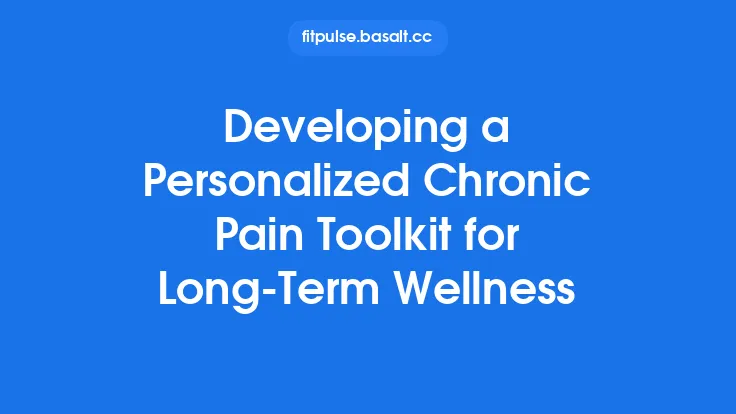Living with chronic pain often feels like a constant negotiation between the desire to stay active and the fear of aggravating discomfort. While many approaches focus on medication, surgery, or intensive rehabilitation, a surprisingly effective—and sustainable—strategy lies in the consistent practice of low‑impact exercise. By selecting movements that minimize joint stress while still providing cardiovascular, metabolic, and neuromuscular stimulus, individuals can experience meaningful pain reduction, improve functional capacity, and support the biological processes that underlie healthy aging. This article explores the science behind low‑impact exercise, outlines practical ways to integrate it into daily life, and highlights how these activities contribute to longevity without overlapping the topics covered in neighboring guides.
Why Low‑Impact Exercise Works for Chronic Pain
Mechanical Load That Is Gentle Yet Sufficient
Low‑impact modalities such as walking, stationary cycling, swimming, and elliptical training generate forces that stay within the safe range for compromised joints and soft tissues. Unlike high‑impact activities (e.g., running or plyometrics), the peak ground‑reaction forces are reduced, decreasing the risk of micro‑trauma while still providing enough mechanical stimulus to promote cartilage nutrition and synovial fluid circulation. This gentle loading encourages the maintenance of joint health through mechanotransduction pathways that signal chondrocytes to produce extracellular matrix components.
Anti‑Inflammatory Cascade
Exercise of moderate intensity triggers the release of myokines—muscle‑derived cytokines such as interleukin‑6 (IL‑6) in its anti‑inflammatory role. These myokines down‑regulate pro‑inflammatory mediators (TNF‑α, IL‑1β) that are often elevated in chronic pain states. Over time, regular low‑impact sessions can shift the systemic inflammatory profile toward a more balanced state, reducing peripheral sensitization and the perception of pain.
Endogenous Opioid Activation
Physical activity stimulates the brain’s reward circuitry, prompting the release of endogenous opioids (e.g., β‑endorphins) and neurotransmitters like dopamine and serotonin. These chemicals modulate pain pathways at both spinal and supraspinal levels, providing a natural analgesic effect that can complement other therapeutic modalities.
Neuroplastic Adaptations
Repeated low‑impact movement reinforces sensorimotor pathways, enhancing proprioceptive acuity and motor control. Improved neuromuscular coordination reduces aberrant movement patterns that often exacerbate pain, while also fostering cortical re‑organization that can diminish central sensitization—a key factor in chronic pain chronification.
Cardiovascular and Metabolic Benefits Linked to Longevity
Consistent aerobic activity improves endothelial function, lowers blood pressure, and enhances lipid profiles—all predictors of reduced cardiovascular mortality. Moreover, low‑impact exercise improves insulin sensitivity and mitochondrial efficiency, mitigating age‑related metabolic decline. These systemic benefits translate into a lower risk of comorbidities that can compound pain and accelerate functional loss.
Selecting the Right Low‑Impact Modalities
| Modality | Primary Physiological Stress | Typical Intensity (RPE) | Pain‑Friendly Features |
|---|---|---|---|
| Walking (incline or flat) | Weight‑bearing aerobic stimulus, mild joint compression | 3–5 | Adjustable speed, easy to pause, can be performed outdoors or on a treadmill |
| Stationary Cycling | Lower‑body aerobic work with minimal impact | 4–6 | Seated position reduces axial load; resistance can be fine‑tuned |
| Elliptical Trainer | Full‑body aerobic motion with gliding footplates | 4–6 | Simultaneous upper‑body engagement; low shear forces on knees/hips |
| Swimming / Aquatic Aerobics | Full‑body resistance from water, buoyancy reduces load | 3–5 | Hydrostatic pressure supports joints; temperature can be therapeutic |
| Rowing (ergometer) | Upper‑ and lower‑body aerobic effort, low impact on joints | 4–6 | Controlled stroke pattern; seated position protects lower extremities |
| Recumbent Bike | Focused lower‑body aerobic work, back support | 3–5 | Reclined seat reduces lumbar strain; easy to mount/dismount |
| Low‑Impact Dance (e.g., ballroom, gentle salsa) | Rhythmic aerobic activity, coordination | 3–5 | Social engagement; adaptable step height |
When choosing a modality, consider personal preferences, accessibility, and any specific joint limitations. The most effective exercise is the one that can be performed consistently without provoking flare‑ups.
Designing a Sustainable Low‑Impact Exercise Routine
Frequency and Duration
- Baseline Recommendation: 3–5 sessions per week.
- Session Length: Start with 10–15 minutes and gradually increase to 30–45 minutes as tolerance improves.
- Progression Principle: Add 5 minutes to the total duration every 1–2 weeks, or increase resistance/pace by ~5–10 % once the current workload feels easy.
Intensity Monitoring
- Rate of Perceived Exertion (RPE): Aim for 3–6 on a 0–10 scale (moderate intensity).
- Talk Test: You should be able to hold a conversation without gasping.
- Heart Rate Zones: For most adults, 50–70 % of maximal heart rate (220 – age) provides a safe aerobic window.
Warm‑Up and Cool‑Down (Non‑Stretching)
- Warm‑Up: 5 minutes of low‑intensity movement (e.g., slow walking, gentle pedal) to raise core temperature and prime circulation.
- Cool‑Down: 5 minutes of gradually decreasing pace to facilitate venous return and prevent abrupt blood pressure shifts.
Pain‑Guided Adjustments
- Pain Scale Check: Use a 0–10 numeric rating before, during, and after each session.
- Threshold Rule: If pain rises >2 points above baseline during activity, reduce intensity or pause.
- Post‑Exercise Evaluation: Mild soreness that resolves within 24 hours is acceptable; sharp or lingering pain warrants modification.
Periodization for Longevity
- Micro‑Cycles (Weekly): Alternate between “steady‑state” days (consistent moderate pace) and “interval” days (short bursts of higher effort followed by recovery).
- Macro‑Cycles (Quarterly): Every 8–12 weeks, incorporate a “deload” week with reduced volume to allow tissue remodeling and prevent overuse.
Integrating Low‑Impact Exercise Into Everyday Life
- Active Commuting: Replace short car trips with walking or cycling. Even a 10‑minute walk to the mailbox adds cumulative aerobic load.
- Workplace Breaks: Set a timer to stand and march in place for 2 minutes every hour. Over an 8‑hour day, this yields 16 minutes of low‑impact movement.
- Social Activities: Join a community walking group, water‑aerobics class, or low‑impact dance club. Social reinforcement improves adherence.
- Home‑Based Options: Keep a compact elliptical or recumbent bike in a spare room. Pair sessions with favorite podcasts or audiobooks to make the time enjoyable.
- Seasonal Adaptations: Use indoor trainers during inclement weather; switch to outdoor swimming or lake walking when temperatures rise.
The Longevity Connection: How Low‑Impact Exercise Extends Healthspan
Cardiovascular Resilience
Regular aerobic activity improves arterial compliance and reduces arterial stiffness—a predictor of cardiovascular events. By maintaining a healthier vascular system, the body delivers oxygen and nutrients more efficiently to all tissues, including those involved in pain processing.
Musculoskeletal Preservation
Low‑impact loading stimulates osteoblastic activity, supporting bone mineral density without the high fracture risk associated with heavy resistance work. Simultaneously, it preserves muscle mass (especially type I fibers) that are essential for postural stability and gait, reducing fall risk—a major contributor to morbidity in older adults.
Metabolic Homeostasis
Exercise enhances mitochondrial biogenesis via up‑regulation of PGC‑1α, leading to improved oxidative capacity. Better mitochondrial function reduces the accumulation of reactive oxygen species (ROS), which are implicated in cellular aging and chronic pain sensitization.
Cognitive Benefits
Aerobic activity increases cerebral blood flow and promotes neurogenesis in the hippocampus. These changes are linked to improved executive function and memory, which are protective against age‑related cognitive decline—a factor that can indirectly influence pain perception and coping strategies.
Telomere Maintenance
Emerging research suggests that consistent moderate‑intensity exercise is associated with slower telomere attrition. Longer telomeres correlate with reduced cellular senescence, offering a biological substrate for extended healthspan.
Safety Considerations and Contraindications
| Situation | Recommended Modification |
|---|---|
| Acute flare‑up of joint pain | Reduce intensity to a very gentle pace (RPE ≤ 2) or switch to water‑based activity for buoyancy support. |
| Unstable cardiovascular condition | Obtain medical clearance; consider seated aerobic options (e.g., recumbent bike) with close heart‑rate monitoring. |
| Severe balance impairment | Use handrails, seated equipment, or supervised sessions with a therapist. |
| Post‑surgical restrictions | Follow surgeon’s timeline; begin with passive range‑of‑motion and progress to low‑impact aerobic as tolerated. |
| Peripheral neuropathy | Choose closed‑foot footwear, ensure smooth surfaces, and avoid high‑speed intervals that could exacerbate numbness. |
Always consult a healthcare professional before initiating a new exercise regimen, especially when chronic pain is accompanied by comorbid medical conditions.
Tracking Progress Without Over‑Monitoring
While detailed pain‑tracking tools belong to a separate article, a simple, low‑burden method can still provide valuable feedback:
- Weekly Log Sheet: Record the day, modality, duration, and RPE. Note any “pain spikes” (≥2‑point increase) and the activity context.
- Monthly Functional Check: Perform a brief functional test (e.g., 6‑minute walk distance) to gauge aerobic capacity improvements.
- Subjective Well‑Being Rating: At the end of each week, rate overall energy, mood, and sleep quality on a 0–10 scale. Trends often correlate with exercise consistency.
These minimal data points help fine‑tune the program without the complexity of full‑scale monitoring systems.
Frequently Asked Questions
Q: Can low‑impact exercise replace medication for chronic pain?
A: It can reduce reliance on analgesics for many individuals, but it is not a universal substitute. Always discuss medication adjustments with a prescriber.
Q: How soon can I expect pain relief?
A: Some people notice reduced pain after 2–3 weeks of consistent activity, while others may require 6–8 weeks. Patience and gradual progression are key.
Q: Is it safe to combine low‑impact exercise with occasional high‑impact activities?
A: Occasionally incorporating higher‑impact movements (e.g., short bouts of jogging) can be safe if the underlying joints tolerate it, but the core program should remain low‑impact to protect chronic pain sites.
Q: Do I need special equipment?
A: No. A sturdy pair of walking shoes, a bike or elliptical if available, and access to a safe swimming environment are sufficient. Resistance bands can be added for gentle strength work, but they are not essential for the core aerobic focus.
Bottom Line
Low‑impact exercise offers a scientifically grounded, accessible, and adaptable pathway to alleviate chronic pain while simultaneously nurturing the physiological systems that support a longer, healthier life. By selecting appropriate modalities, structuring sessions around moderate intensity, and weaving movement into everyday routines, individuals can experience meaningful pain reduction, enhanced functional capacity, and the longevity benefits that stem from sustained aerobic conditioning. The approach is pragmatic—requiring modest time, minimal equipment, and a focus on consistency—yet powerful enough to shift the trajectory of chronic pain from a limiting condition to a manageable aspect of a vibrant, active life.





